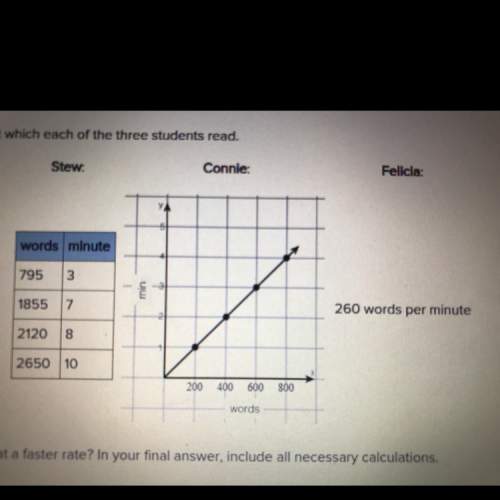Let u = 〈−2,5〉 and v = 〈4,3〉.
a. draw a diagram to illustrate v and u, and then find v + u usi...

Mathematics, 22.10.2019 01:00 igivebirth4170
Let u = 〈−2,5〉 and v = 〈4,3〉.
a. draw a diagram to illustrate v and u, and then find v + u using the parallelogram rule.
b. draw a diagram to illustrate 2v, and then find 2v + u using the parallelogram rule.
c. draw a diagram to illustrate −v, and then find u − v using the parallelogram rule.
d. draw a diagram to illustrate 3v and −3v.
i. how do the magnitudes of these vectors compare to one another and to that of v?
ii. how do the directions of 3v and −3v compare to the direction of v?

Answers: 3


Another question on Mathematics

Mathematics, 21.06.2019 16:00
Whose conclusion is correct? choose all that apply. (two max) elijah emily edward esme
Answers: 2

Mathematics, 21.06.2019 18:00
How many glue sticks are in a basket containing 96 scissors, if the ratio of glue sticks to scissors is 19 to 57.
Answers: 1

Mathematics, 21.06.2019 22:20
In a young single person's monthly budget, $150 is spent on food, $175 is spent on housing, and $175 is spend on other items. suppose you drew a circle graph to represent this information, what percent of the graph represents housing?
Answers: 1

Mathematics, 22.06.2019 01:10
If the diagram polygon abcd is a reflection across ef to make polygon a'b'c'd'.
Answers: 2
You know the right answer?
Questions

Mathematics, 30.10.2021 17:00


Medicine, 30.10.2021 17:00

English, 30.10.2021 17:00

Mathematics, 30.10.2021 17:10


Health, 30.10.2021 17:10




Chemistry, 30.10.2021 17:10

Mathematics, 30.10.2021 17:10

Mathematics, 30.10.2021 17:10


Mathematics, 30.10.2021 17:10





Mathematics, 30.10.2021 17:10




